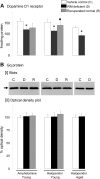Prefrontal inositol triphosphate is molecular correlate of working memory in nonhuman primates
- PMID: 20181603
- PMCID: PMC6633946
- DOI: 10.1523/JNEUROSCI.4565-09.2010
Prefrontal inositol triphosphate is molecular correlate of working memory in nonhuman primates
Abstract
Working memory (WM) is a process of actively maintaining information in the mind for a relatively short period of time, and prefrontal cortex (PFC) has been thought to play a central role in its function. However, our understanding of underlying molecular events that translate into WM behavior remains elusive. To shed light on this issue, we have used three distinct nonhuman primate models of WM where each model represents three WM conditions: normal control, WM-deficient, and recuperated to normal from WM deficiency. Based on the hypothesis that there is a common molecular substrate for the coding of WM behavior, we have studied the relationship of these animals' performance on a WM task with their PFC levels of molecular components associated with Gq-phospholipase C and cAMP pathways, with the idea of identifying the footprints of such biomolecules. We observed that in all of the primate models WM deficiency was strongly related to the reduced concentration of IP(3) in PFC, whereas recuperation of WM-deficient animals to normal condition was associated with the normalization in IP(3) level. However, this correlation was absent or weak for cAMP, active protein kinase A, dopamine D(1) receptor, and Gq protein. In addition, WM deficiency related not only to pharmacological conditions but also to aging. Thus, it is suggested that optimal IP(3) activity is essential for normal WM function and the maintenance of intracellular IP(3)-mediated Ca(2+) level in PFC may serve as biochemical substrate for the expression of WM behavior.
Figures




References
-
- Abdul-Ghani MA, Valiante TA, Carlen PL, Pennefather PS. Metabotropic glutamate receptors coupled to IP3 production mediate inhibition of IAHP in rat dentate granule neurons. J Neurophysiol. 1996;76:2691–2700. - PubMed
-
- Baddeley A. Working memory. Science. 1992;255:556–559. - PubMed
-
- Butters N, Pandya D, Sanders K, Dye P. Behavioral deficits in monkeys after selective lesions within the middle third of sulcus principalis. J Comp Physiol Psychol. 1971;76:8–14. - PubMed
-
- Castner SA, Williams GV, Goldman-Rakic PS. Reversal of antipsychotic-induced working memory deficits by short-term dopamine D1 receptor stimulation. Science. 2000;287:2020–2022. - PubMed
Publication types
MeSH terms
Substances
LinkOut - more resources
Full Text Sources
Medical
Miscellaneous
